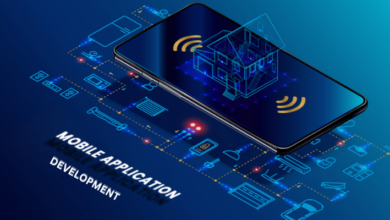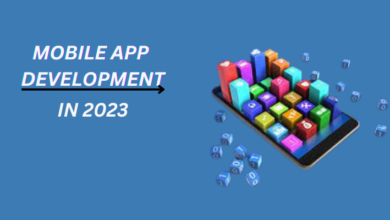Power of Mobile Applications: Future of Mobile Applications

Software applications that run on mobile devices are developed through a process called mobile application development. To use remote computer resources, a mobile application usually needs a network connection. Therefore, developing installable software packages (code, binaries, assets, etc.), integrating backend services (such data access via an API), and testing the application on target devices are all part of the mobile development process.
Table of Contents
TogglePlatforms for Devices and Mobile Applications
The current smartphone market is dominated by two platforms. The first is Apple Inc.’s iOS platform. The operating system behind Apple’s well-known iPhone smartphone lineup is called the iOS platform. Google’s Android is the second. In addition to Google products, numerous other original equipment manufacturers (OEMs) employ the Android operating system when creating their own smartphones and other smart devices.
While creating applications for these two platforms is similar in several ways, creating apps for iOS and Android requires different software development kits (SDKs) and development toolchains. Apple only utilizes iOS for its own products, whereas Google makes Android available to other businesses as long as they fulfill certain standards, such shipping smartphones with specified Google apps. By focusing on these two platforms, developers may create apps for hundreds of millions of devices.
Other Ways to Develop Mobile Applications
There are four main methods for developing mobile applications.
- Native Mobile Applications
- Cross-Platform Native Mobile Applications
- Hybrid Mobile Applications
- Progressive Web Applications
Every one of these methods for creating mobile applications has benefits and drawbacks of its own. Developers take into account the intended user experience, the processing power and native features needed by the app, the development budget, the deadlines, and the resources available for app maintenance when determining which development style is best for their projects.
Why Locate the Hybrid/Cross-platform Approach?
The fact that developing native mobile applications calls for a very specific skill set is one of its issues. The language families most commonly used for native programming, C and Java, have thriving and sizable developer communities, but fewer developers are familiar with platform-specific variants of those languages and their corresponding IDEs. Because of the high demand for qualified native app developers, many businesses find it difficult to hire and retain them on staff and usually end up hiring outside design and development houses to construct their apps.
Why Hybrid and Cross-platform Frameworks Work?
With hybrid apps, developers may leverage HTML5, CSS, and JavaScript web technologies to create web applications that function like native apps on the device by encasing them in a container. The majority of web application code may be utilized to create mobile applications since hybrid mobile apps are simply web applications operating in an embedded browser environment. For web developers who wish to create mobile apps rapidly, hybrid development is a good option because of the growing rendering and runtime performance of mobile browsers.
Similar to this, PWAs are created using standard web application programming technologies, such as HTML5, CSS, and JavaScript, and are first seen via a device’s or computer’s browser.
The Lifecycle of Mobile Application Development

A mobile application consists of two interconnected main parts: the services “Back-End” that supports the mobile front-end and the mobile application “Front-End” that runs on the mobile device.
Back-end versus front-end
Mobile applications saw a similar transformation in the early years of the modern smartphone applications age as did the first websites. Initially, the websites and applications were completely self-contained and served as little more than static adverts for the company, product, or service.
As network capabilities and connectivity increased, however, the applications connected to more external data and information sources and became more dynamic, updating their user interface and content based on information gathered from data sources via network queries.
Because of this, back-end services that supply data for consumption through the mobile front-end are increasingly incorporated into and dependent upon mobile front-end apps. For instance, product details for e-commerce applications or flight information for travel and reservation apps can be examples of such data. In the case of a mobile game, the data could contain player avatars, scores, and new levels or challenges.
How does Front-end interact with Back-end?
The back-end provides the data to the mobile front-end using a range of service calls, including APIs. Sometimes, the company creating the mobile application may also be the owner and operator of these APIs. In other situations, a third company may be in charge of the API, and the mobile application receives access through a paid contract.
A developer could, for instance, call media or advertising company services to collect social media or advertising content. In this scenario, obtaining credentials and a key that allow access to the API and specify how it may be used, how much it will cost, how often it can be used, and how much data can be requested over what time period may require a developer to sign a contract.
Why Do Developers Use an Online Store?
The majority of applications entail back-end service creation and management falling under the purview of mobile developers. It’s possible that the mobile developer lacks specialization or expertise in setting up and managing a back-end infrastructure.
In this situation, developers might find it more convenient to use a backend-as-a-service provider, which is a cloud services provider that manages back-end capabilities. This allows developers to concentrate entirely on the features and functionality they are creating for their app, without having to worry about issues with scalability, security, and dependability.
The Front End of a Mobile Application
The user’s experience with the application’s visual and interactive elements is known as the mobile front-end. Usually, it is installed on the device, or at the very least, there is an icon for it that can be found pinned in the program catalog or on the home screen. The application can be accessed through the device’s browser, as is the case with PWAs, side-loaded straight onto the device, or downloaded from the platform app store.
What Does a Workflow for Front-End Development Look Like?
Developers who identify themselves as mobile application programmers typically mean that they are proficient in the programming languages and technologies needed to create the application’s front end.
The number of individuals working on the front-end mobile app development and design may vary greatly, depending on the size of the team creating it. The number of members on the team might vary from one developer handling all aspect of the app’s development to tens, hundreds, or even more with specialized knowledge.
For instance, the creation of an application’s icons, backdrop, colors, themes, and other visual components may fall under the purview of specialized creative or graphics designers. The group may also include designers of user interfaces and user experiences who focus on component layout and user interaction. For some kinds of games, a team may include of engineers and motion graphic designers who create engines that control the physics of how objects move within the application, such as a racing game car.
How Do Mobile Applications and the Backend Interact?
Building the app logic, which is in charge of making network calls to the back-end services, retrieving data, and updating the data in the back-end systems with new information created from the app, is an essential component of the development process, regardless of the size of the team.
Most of the time, a range of application programming interfaces—APIs for short—are used to access these back-end services. There are many different kinds of APIs, including GraphQL and REST, as well as numerous ways to access them. Many of the specialized services must be connected into the application using a software development kit, or SDK, however some back-end service APIs are accessible directly to the application through calls within the platform itself. The application can utilize the APIs specified in the SDK after adding the SDK to it through the development environment.
How Can I Work with the Data in the Backend?
A database that houses data utilized by the app is an example of a back-end service for a mobile front-end. The mobile developer would require knowledge of the database’s network location, access protocol, login credentials for authorizing and authenticating data access, and the particular database commands required to retrieve the required data in order to directly access the database.
The back-end of a mobile application
Reliable back-end services are necessary to build high-quality mobile applications that excite and keep users, regardless of the front-end platform or development technique employed.
The developers have a number of crucial architectural choices to make because back-end services are essential to the success of the mobile application. These choices include deciding which services to develop internally and which to use from third parties, as well as whether to manage and maintain their own services or make use of outside resources.
Additionally, they should nearly always use cloud-based services to create and manage their backend infrastructure, even for services they develop themselves.
Important Mobile App Services
Mobile application developers have a plethora of cloud and third-party services at their disposal to expedite the creation and deployment of their applications. A developer isn’t likely to be able to become an authority in each of these distinct services, though.
Rather, mobile developers ought to seek out a development environment that facilitates the seamless integration, utilization, and consumption of the most frequently needed features into their applications, all the while maintaining the flexibility to leverage the numerous individual services that are accessible.
Essential
- User Management and Sign-up/Sign-in
- Social media login (e.g., Twitter, Facebook, etc.)
- Data and User Involvement
- Notifications via Push
- Actual Testing of Devices
Data Sources
- Online Data Storage
- Data in Real Time and Offline
- Functions of Application Logic and Cloud
Machine Learning
- Dialog-Based Bots
- Video and Image Identification
- Voice Identification
Future of Mobile Application Development:
- Artificial Intelligence (AI) and Machine Learning (ML): AI and ML are poised to revolutionize mobile app development, enabling more personalized, intelligent, and adaptive experiences. AI-powered features will personalize app recommendations, provide predictive analytics, and enhance user interactions.
- Augmented Reality (AR) and Virtual Reality (VR): AR and VR are transforming the way we interact with the digital world, and mobile apps will play a pivotal role in bringing these technologies to the masses. AR apps will overlay digital information onto the real world, while VR apps will immerse users in fully simulated environments.
- Internet of Things (IoT): The IoT is connecting an ever-growing network of devices, and mobile apps will be the primary interface for managing and interacting with these devices. IoT-enabled apps will control smart homes, wearable devices, and connected cars, providing seamless control and automation.
- Cross-Platform Development: Cross-platform development frameworks like Flutter, React Native, and Xamarin are gaining popularity, enabling developers to create apps for multiple platforms with a single codebase. This efficiency will lead to more innovative and widely accessible apps.
- Low-Code and No-Code Development: Low-code and no-code platforms are democratizing app development, making it accessible to individuals with limited coding expertise. This will empower more people to create their own apps, fostering innovation and entrepreneurship.
- Blockchain Technology: Blockchain technology is poised to transform app security, data ownership, and decentralized applications. Secure blockchain-based transactions and decentralized data storage will enhance user trust and enable new app concepts.
- Cloud Computing and Edge Computing: Cloud computing will continue to provide scalable and cost-effective infrastructure for mobile app development, while edge computing will bring processing power closer to the user, reducing latency and improving real-time experiences.
- Conversational Interfaces and Voice Assistants: Conversational interfaces and voice assistants like Siri, Google Assistant, and Alexa will become increasingly integrated into mobile apps, providing a more natural and intuitive way to interact with apps.
- Wearable Device Integration: Mobile apps will seamlessly integrate with wearable devices, providing users with personalized health and fitness tracking, notifications, and remote device control.
Conclusion
Mobile application development has become an indispensable tool for businesses and individuals alike, transforming how we interact with technology and shaping our daily lives. By understanding the process, embracing emerging technologies, and prioritizing user experience, individuals and organizations can harness the power of mobile apps to create innovative solutions, enhance customer experiences, and drive business growth.
FAQs
What is mobile application development?
These applications, often referred to as “apps,” are tailored to the unique features and capabilities of mobile devices, providing users with a convenient and engaging way to access information, communicate, and perform various tasks.
How do I get my mobile app published on the App Store or Google Play?
To publish your app on the App Store, you’ll need to create an Apple Developer account and submit your app through App Store Connect. For Google Play, you’ll need a Google Play Developer account and submit your app through the Google Play Console.
How do I market my mobile app?
There are various ways to market your mobile app, including:
- App Store Optimization (ASO)
- Social media marketing
- Search engine optimization (SEO)
- Paid advertising
- Influencer marketing
What are the future trends in mobile application development?
Mobile application development is a rapidly evolving field, with emerging technologies like artificial intelligence, augmented reality, and virtual reality opening up new possibilities for innovative and immersive app experiences.





One Comment